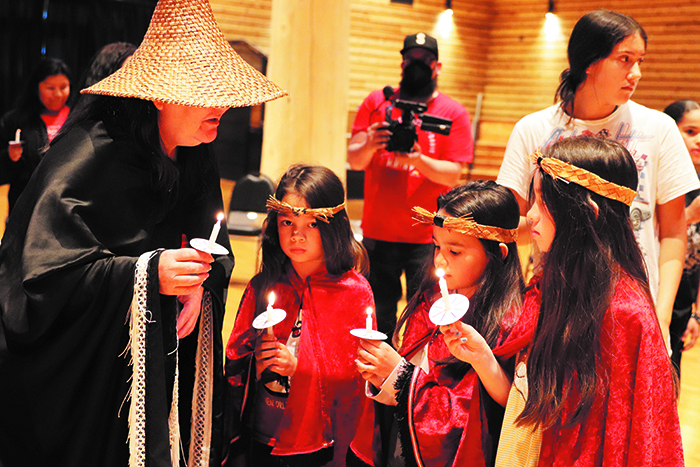
By Kalvin Valdillez, Tulalip News
Another week closer to this year’s Salmon Ceremony, the Tulalip community met once again on Thursday May 5, to practice their traditional songs and dances before the first yubəč, or king salmon, arrives at local waters. The festivities for the honored guest will be held on June 11 this year, beginning at 10:30 a.m., at the Tulalip Longhouse.
The Tulalip Gathering Hall’s acoustics highlighted the fact that the drumbeats were louder and the vocals were stronger this week, as the number of participates continues to grow with each practice. In addition to more drummers and singers, there are notably more shawls and vests on the floor while dancers utilize the entire space of the hall, dancing along to the Tribe’s ancestral songs. Nearly everybody at the third practice session wore red this week, and a couple of people showcased a painted red handprint across their face.
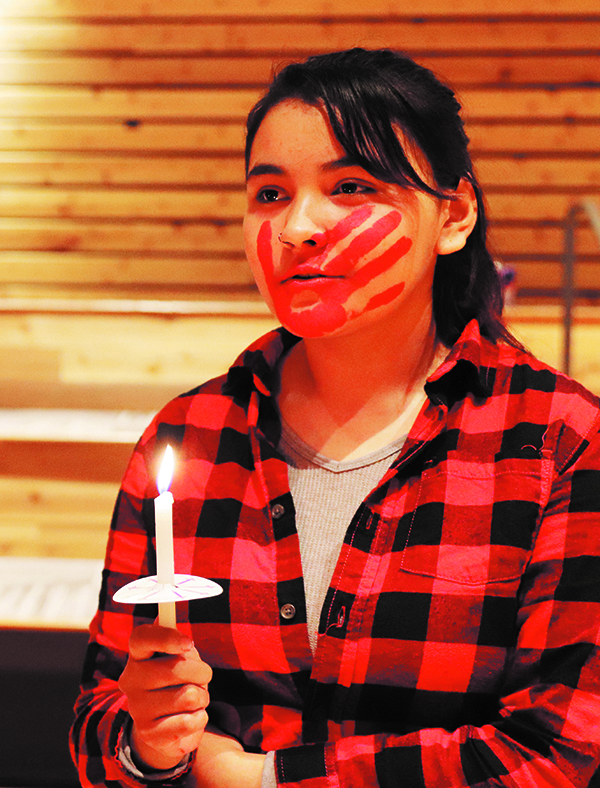
During the weekly gatherings, the people practice an entire walkthrough of the Salmon Ceremony, taking time to explain each song, dance, chant, and blessing. After the revival in 1976, the tribe makes sure to teach the upcoming generation about how Harriette Shelton Dover and a number of Tulalip elders brought the ceremony back following the boarding school era. Almost completely wiped away from existence due to forced assimilation, the Salmon Ceremony is now celebrated at the start of every fishing season.
The ceremony honors the salmon for providing nourishment to the tribal community, while also blessing the local fisherman before they begin harvesting salmon for their families and community this year.
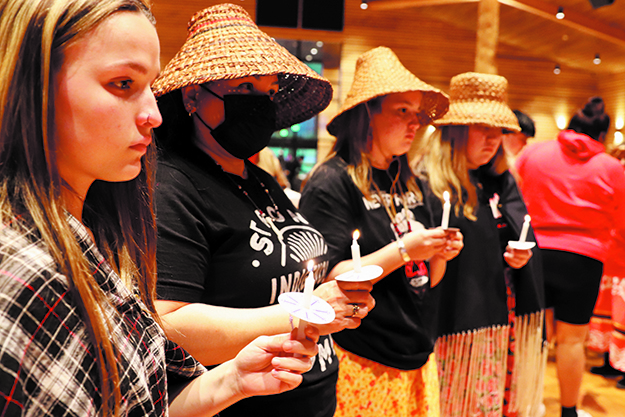
“We honor the gift of our visitor, yubəč, Big Chief King Salmon,” said Tulalip tribal member, Glen Gobin. “We’re harvesting from nature again, it’s how we honor and respect that, to ensure that he’s always going to be there. Him and his people will always be there, returning to take care of our people as they always have.”
As a reminder, Salmon Ceremony practices are held every Thursday at the Tulalip Gathering Hall, beginning at 5:00 p.m. The last practice, on June 9th, will be held at the Tulalip Longhouse. Several tribal leaders, including Chairwoman Teri Gobin, wish to extend a warm welcome to the entire community of Tulalip to the practice sessions to learn about the Salmon Ceremony and all that the traditional event entails, so it can be passed on to the generations of tomorrow.
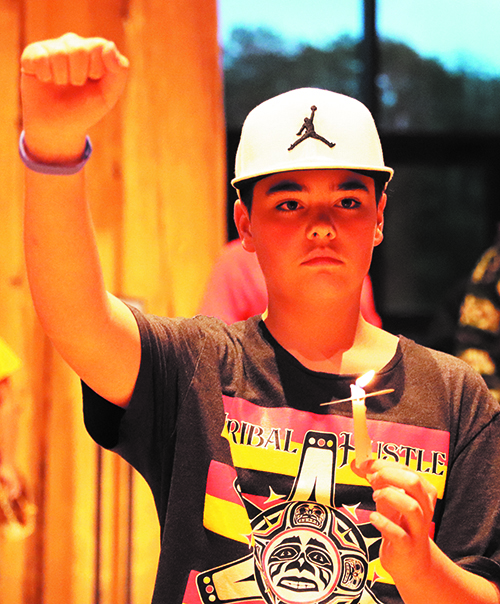
Said Teri, “We’ve come a long way and we’ve been practicing for a lot of years. What is most important now is that we are making sure the young ones are learning the songs, the dances and about those elders who brought it back again.”
Before the last song was performed, Glen explained that this week’s practice was scheduled to end a little bit sooner than usual, while also inviting those in attendance to stay behind for a special candlelight vigil, in remembrance of all the missing Indigenous women and people. The majority of Salmon Ceremony participants did not leave after this week’s practice, but instead spread out from the drum circle in the middle of the floor to seats, also arranged in a circle, placed along the outer edges of the Gathering Hall.
What followed next was a moving tribute held in honor of national MMIWP Awareness Day. Powerful words and heartbreaking stories were shared during the special candlelight vigil and the ceremony provided a safe space for the families of survivors, those individuals missing and those who have passed on, to open up about the national epidemic.
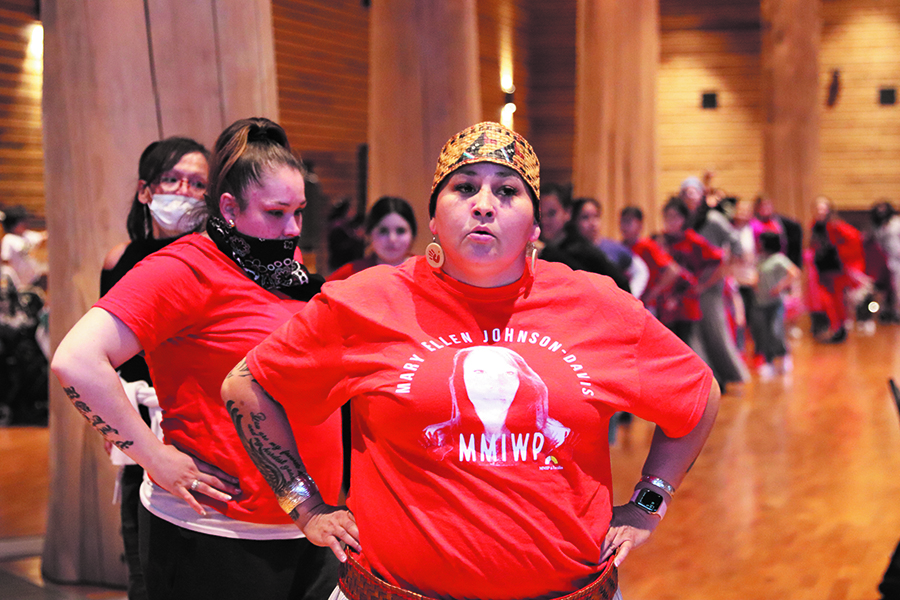
Multiple survivors of domestic violence took the opportunity to warn the young people about the dangers of an abusive relationship, noting that toxic relationships can escalate quickly to unsafe situations. Many of these survivors expressed the difficulty of leaving a dangerous relationship. They also stated that they felt that if they didn’t leave when they did, they might not be here today.
Tribal member, Shawnee Sheldon shared, “Everybody who was in domestic violence, brought awareness tonight. Even though I didn’t speak, I’m a victim of domestic violence. At the age of 17, I was abused by my boyfriend. He isolated me and I was beaten pretty bad. I feared for my life. And at the time, I called my best friend and told her to come and get me and bring me home because I was all the way down in Muckleshoot. She came and got me and I’m forever grateful for her. If she didn’t come for me, I don’t think I would be alive. It sometimes still triggers me. I don’t speak publicly about it, but I can talk individually with people about it, because I know there are people who are put it in the darkness. So just bringing that awareness is huge.”
A number of speakers also urged the youth to be aware of their surroundings at all times, and to reach out for help when it’s needed. Several speakers reiterated to the future generation to be safe and communicative with their families about where they are going, who they are with, and how they are doing because the rate at which Indigenous people go missing continues to climb throughout the nation.
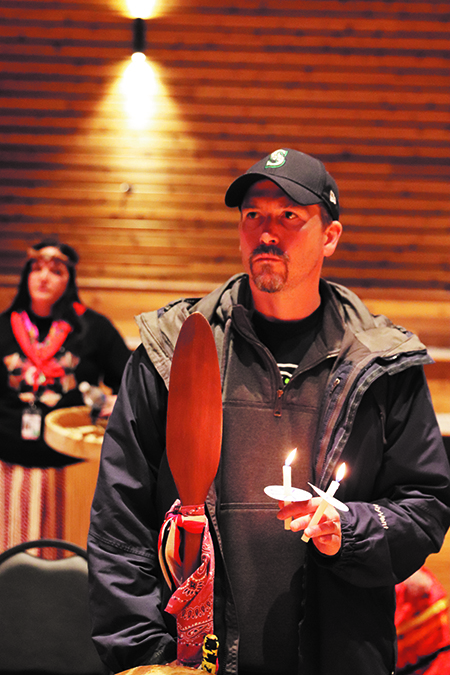
Tribal member and QCT teacher, Margie Santibanez shared, “I came out for the MMIW vigil because I have friends who started out in domestic violence relationships and two of them almost lost their lives to it. Some of my students were murdered, as I worked at the school which is now known as Heritage. My heart has always been heavy. This is my way of being a voice for them, helping the families heal if I can by doing the prayers and teaching the kids what it is to be respectable to each other. That’s my goal, that’s why I came.”
As the candles were lit, the people held an extended moment of silence for the survivors and those we lost due to the epidemic. Tears were shed, hugs were shared, and prayers and songs were offered as the community gathered with heavy hearts on National MMIWP Awareness Day and took an important step towards healing.